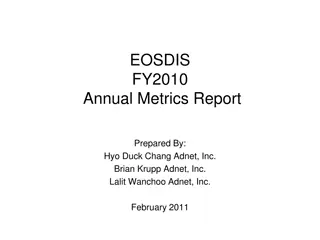Lifelong Data Science Report Overview
This report provides insights into the general statistics and demographics of a data set, including variables of interest such as sex, age range, race, ethnicity, housing status, and more. Questions of interest delve into correlations between demographics and viral load, as well as PCP visit frequency and viral load testing. Visual representations highlight key takeaways on gender distribution, age demographics, racial representation, ethnicity breakdown, and housing status disparities.
Uploaded on Mar 16, 2025 | 1 Views
Download Presentation

Please find below an Image/Link to download the presentation.
The content on the website is provided AS IS for your information and personal use only. It may not be sold, licensed, or shared on other websites without obtaining consent from the author.If you encounter any issues during the download, it is possible that the publisher has removed the file from their server.
You are allowed to download the files provided on this website for personal or commercial use, subject to the condition that they are used lawfully. All files are the property of their respective owners.
The content on the website is provided AS IS for your information and personal use only. It may not be sold, licensed, or shared on other websites without obtaining consent from the author.
E N D
Presentation Transcript
Lifelong Data Science Report
General Stats 3859 data points Variables of interest: Sex Age Range Race Ethnicity Housing Status Case Management Agencies Programs Enrolled/Services Received Viral Load Date of Last Primary Care Provider Visit Date of Last Viral Load Test
Questions of Interest How do demographics correlate with viral load, especially uncontrolled viral load? How often do people visit their PCP without getting VL tested and vice versa?
Sex Most clients are cis men Next highest demographic is cis female More MTF trans people than FTM trans people which makes sense Takeaways: Keep unbalanced data in mind when analysing graphs that use gender
Age Range Clients skew older Few clients who are <25 HIV is often transmitted sexually. There are fewer sexually active people in that age range
Race Majority of clients are white Second highest demographic is Black Takeaway: White people are represented proportionally to their population in Seattle Black people are overrepresented (6.8% in Seattle) Asian people are underrepresented (14.9% in Seattle) Source: Seattle Census Data: https://www.seattle.gov/opcd/population-and-demographics/about-seattle#raceethnicity
Ethnicity Most clients are non- Hispanic (83% non- Hispanic, 17% Hispanic) Most Hispanic clients are Mexican Takeaways: Hispanic clients are overrepresented (6.6% of Seattleites are Hispanic) Source: Seattle Census Data: https://www.seattle.gov/opcd/population-and-demographics/about-seattle#raceethnicity
Housing Status Most clients live in houses/apartments that they own/rent Homeless clients are overrepresented in the data compared to average Seattle homelessness rates 9% here, 1% in Seattle Source: Seattle Times: https://projects.seattletimes.com/2021/project-homeless-data- page/
Case Management Agencies Most clients are served by Lifelong or Harborview Medical Clinic Many case management agencies have fewer than 10 clients This visualization does not include those but the visualizations are available if requested
Programs Enrolled/Services Received The majority of clients in this data set receive/use ~3 services or programs. The next highest percentage uses 2, while the third highest receives 4. Important to note that once number of services or programs are greater than 5, the percentages drop rather quickly.
Race and HIV Stage Majority of clients are white with over 50% for all three HIV/AIDS stages Second highest demographic are black Overrepresented in the data, compared to Seattle demographics https://www.seattle.gov/opcd/population-and-demographics/about-seattle#raceethnicity
Viral Load VL Results are heavily clustered towards a lower Viral Load More than 90% of the clients have a VL lower than 10,000 Around 89% of the clients have a VL lower than 100
Gender and Viral Load Note that this graph uses a log scale on the y-axis, so the small differences in height mean a lot The vast majority of clients have VL < 100,000
Gender and Uncontrolled Viral Load 13.7% female and 86.3% male Compare to distribution of all clients:
Age Ranges and Viral Load VL varies more the younger a client is All age ranges have the same low averages The older clients get, the less variation in VL there is. There are more clients in older age ranges
Age Ranges and Uncontrolled Viral Load Clients who are 36-55 show the most variability 65+ age range only includes 1 data point While 0-25 age range has a lot of variability (seen in last slide), they have the lowest VL counts of the uncontrolled set
Race and Viral Load In this graph, the middle quartile/median is very similar for all racial identifications. White and Black races have significantly more outliers past Q4 than NH/PI, Asian, and AI/AN races. This is because there are significantly more white and Black identified clients than the other races.
Race and Uncontrolled Viral Load Only 1 datapoint in this set in the Asian category, 1 in NH/PI, 2 in AI/AN Black clients have more variability in VL Black and White clients have about the same average
Ethnicity and Viral Load Majority of the clients are non- Hispanic; this group has a larger distribution of viral loads. Hispanic individuals have the same median range which indicates majority of Hispanic clients have as average the same detectable Viral Load as compared to the majority of their non-Hispanic counterparts.
Ethnicity and Uncontrolled Viral Load Majority of the clients are non-Hispanic; this group has a larger distribution of viral loads. Hispanic individuals have a higher median and inter-quartile range which indicates majority of Hispanic clients have higher viral loads as compared to the majority of their non-Hispanic counterparts.
Housing Status and Viral Load While Homeless, Apartment, and Living with Family present large outliers, it is clear that those living with other people, such as friends and family, have generally tested for higher viral loads overall. This data is partially proportional to the amount of points in the data set, and could be part of the reason for this correlation.
Housing Status and Uncontrolled Viral Load Similar to the controlled Viral load, it appears that those more frequently exposed to people closely have higher general viral loads. Here, the variability of the Family/Friends category to be much wider than where people who own/rent.
Case Management Agencies and Viral Load From this graph, we can understand that Lifelong and Harborview Madison Clinic have the most outliers past its Q4. An explanation for this is that these two agencies have the most clients out of the rest, meaning their box plots contain a significant amount of data points compared to the rest of the agencies in the dataset
Case Management Agencies and Uncontrolled Viral Load Lifelong and Harborview Madison Clinic both have the largest distribution in terms of the viral load size of their clients. Harborview services clients with the lowest and highest viral loads. Lifelong services the second largest group of clients, however, support individuals with a lower viral load than Harborview.
Programs/Services and Viral Load The clients with the highest viral loads tend to use fewer services
Programs/Services and Uncontrolled Viral Load Outliers include people that used 7 or 8 services, and people that used 0 Like in the full set of clients with detectable VLs, clients who use 1- 2 services show the most variability in VL.
Data of Last PCP Visit and Date of Last Viral Load Test Most clients did their last VL test after 2020, with a small amounts not having a VL test since 2016. Most clients who had VL tests in recent years (Last 1-2 years) have also had a PCP check-up in the same amount of time. Some clients who have had a VL test in the recent years (Last 1-2 years) have not had a PCP check-up in the past 1-2 years. vertical lines mean that people are not going to the doctor but continuing to get VL tested























